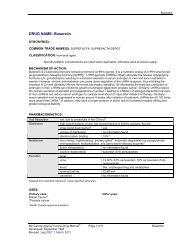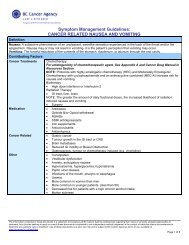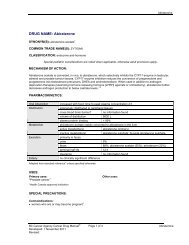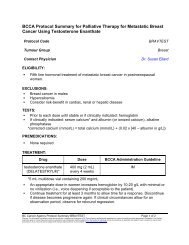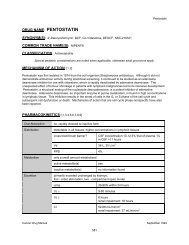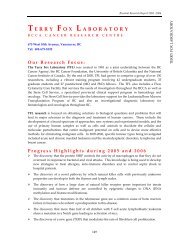CHEMOTHERAPEUTIC AGENTS, ADMINISTRATION OF
CHEMOTHERAPEUTIC AGENTS, ADMINISTRATION OF
CHEMOTHERAPEUTIC AGENTS, ADMINISTRATION OF
You also want an ePaper? Increase the reach of your titles
YUMPU automatically turns print PDFs into web optimized ePapers that Google loves.
C-252<br />
Nursing Practice Reference<br />
Title:<br />
<strong>CHEMOTHERAPEUTIC</strong> <strong>AGENTS</strong>, <strong>ADMINISTRATION</strong> <strong>OF</strong>:<br />
Effective Date: December, 2007 Approved:<br />
Sites: All VC VIC FVC CSI Other<br />
Reason for Directive:<br />
1. To provide guidelines for the safe administration of chemotherapeutic agents.<br />
Index<br />
Page(s)<br />
Administration of Chemotherapeutic Agents ............................................................ 2 – 5<br />
1. Checking Chemotherapeutic Agents' Orders ..................................... 6<br />
2. Methods of Administration:<br />
A. Intravenous -<br />
Infusion ..............................................................................<br />
Side Arm Route ................................................................<br />
7<br />
8<br />
B. Intrathecal -<br />
Via lumbar puncture..........................................................<br />
Via Ommaya Reservoir ....................................................<br />
9 – 10<br />
11 – 12<br />
C. Intraperitoneal ………………………………………………………<br />
Via Peritoneal Dialysis Catheter (External) …..……….<br />
Via Peritoneal Port ………………………………………..<br />
13 – 14<br />
15 – 17<br />
18 – 19<br />
Documentation .............................................................................................................. 20<br />
References ..................................................................................................................... 20 – 22<br />
Appendix 1: IV Set Up for Administration of Taxanes ................................. 23<br />
Appendix 2: About the Ommaya Reservoir ................................................... 24<br />
2B: Diagram of an Ommaya Reservoir ........................................... 25<br />
Appendix 3: Managing Continuous Chemotherapy Infusions ..................... 26<br />
Appendix 4: Standard Tubing Set-Up for INPATIENT Flurouracil (5 FU)<br />
Infusions .......................................................................................<br />
27 - 28<br />
Appendix 5: Potential Complications and Prevention and Management<br />
Strategies for IP Chemotherapy ………………………………….<br />
29<br />
Page 1 of 29
C-252<br />
<strong>ADMINISTRATION</strong> <strong>OF</strong> <strong>CHEMOTHERAPEUTIC</strong> <strong>AGENTS</strong><br />
Also See BCCA Systemic Therapy Program Policies on the Web at:<br />
http://www.bccancer.bc.ca/HPI/ChemotherapyProtocols/Policies.htm<br />
• V-10 Cytotoxic Agents, Safe Handling Standards<br />
• III-10 Chemotherapy Process<br />
• III-20 Prevention and Management of Extravasation<br />
• III-50 Administration of Cytotoxic Drugs by Intrathecal Route via Lumbar Ommaya<br />
Reservoir<br />
• III-80 Algorithm for Assessment of Needle Placement / Catheter Patency in CVC<br />
Devices.<br />
• IV-10 Acute Hypersensitivity Reactions to Chemotherapeutic Agents.<br />
Directives:<br />
Education:<br />
1. The RN administering cytotoxic agents will have completed a Chemotherapy Certification<br />
Program http://www.bccancer.bc.ca/HPI/CE/Nursing/chemo/certification/default.htm as<br />
outlined by the employer. The RN participating in the chemotherapy certification practicum<br />
may administer cytotoxic agents under the supervision of a chemotherapy preceptor or<br />
clinical nurse leader.<br />
2. Each chemotherapy certified RN must meet the requirements of continuing competency in<br />
chemotherapy annually.<br />
http://www.bccancer.bc.ca/HPI/CE/Nursing/chemo/continuingcomp/default.htm<br />
Checking Orders:<br />
3. All orders for chemotherapeutic agents will be checked by a chemotherapy certified RN,<br />
prior to administration of these agents to the patient, as per Nursing Directive C-252,<br />
http://www.bccancer.bc.ca/HPI/Nursing/References/NursingBCCA/C-252.htm and<br />
Provincial Systemic Therapy Policy III-10<br />
http://www.bccancer.bc.ca/HPI/ChemotherapyProtocols/Policies.htm . Discrepancies<br />
exceeding plus or minus 5% of the dose, calculated according to the patient’s treatment<br />
plan, must be clarified with the physician.<br />
4. An RN who is caring for a patient on multi-day chemotherapy and who has not done a full<br />
chemotherapy check on that patient for the current course of treatment, will do so<br />
according to C-252, Section A, “Checking Chemotherapeutic Agents’ Orders”.<br />
5. All orders for chemotherapeutic agents will be written by a physician. To facilitate drug<br />
preparation, changes to a previously written order may be made by a pharmacist upon<br />
verbal order from a physician. However, the RN will not administer the dose until the new<br />
order has been signed and dated by the physician.<br />
Page 2 of 29
6. Before connecting a patient’s IV to a mechanical ambulatory infusion pump, the<br />
programming of that pump and infusion will be checked independently by 2 chemotherapy<br />
certified nurses.<br />
C-252<br />
7. A Registered Nurse (RN) will not accept telephone orders for chemotherapeutic agents or<br />
for adjustments to doses of these agents.<br />
Administration:<br />
8. Any BCCA personnel administering chemotherapeutic agents will follow procedures in<br />
Nursing Directive C-252<br />
http://www.bccancer.bc.ca/HPI/Nursing/References/NursingBCCA/C-252.htm and/or<br />
relevant Site Directives.<br />
9. Some routes are designated for administration by physician only. Consult BCCA -<br />
Approved Parenteral Routes List in the Parenteral Drug Therapy Manual (PDTM).<br />
10. Chemotherapy medications are not usually administered concurrently via Y-site, even if<br />
they are compatible.<br />
11. Intrathecal administration of chemotherapeutic agents is carried out by physicians. Only<br />
chemotherapy certified RNs will assist with this procedure as per Provincial Systemic<br />
Therapy Policy III-50<br />
http://www.bccancer.bc.ca/HPI/ChemotherapyProtocols/Policies.htm. The RN will assist<br />
the physician by verifying medications, educating and supporting the patient/family and<br />
monitoring the patient's condition. RNs assisting with this procedure must be certified to<br />
administer chemotherapy.<br />
12. When patients receive chemotherapeutic agents via the intrathecal route in fluoroscopy<br />
department, the RN will is verify the medications on the ward. The physician is then<br />
responsible for taking the medications to fluoroscopy to administer.<br />
13. For chemotherapeutic agents that have a known high risk of hypersensitivity reactions (see<br />
Systemic Therapy Policy III-60)<br />
http://www.bccancer.bc.ca/HPI/ChemotherapyProtocols/Policies.htm<br />
the RN will remain with the patient during the first 10 minutes of the infusion, and confirm<br />
that a physician is in the building and available immediately if paged on an urgent basis.<br />
14. A vesicant drug, when given peripherally, will be administered via the sidearm of an infusing<br />
primary IV line. Exceptions to this Policy will be noted in the PPOs and in the Cancer Drug<br />
Manual.<br />
15. A vesicant drug that must be given as a peripheral infusion will be supplied in a 50 ml<br />
minibag and administered by gravity over the time specified in the order as a secondary<br />
medication through a free-flowing IV. The RN will remain with the patient, and will check<br />
blood return and assess the IV site every 2 minutes throughout the procedure.<br />
16. A vesicant drug when given peripherally must never be administered via an infusion pump.<br />
Page 3 of 29
C-252<br />
17. Chemotherapy, both vesicant and non-vesicant, given through functioning central venous<br />
access devices (i.e., tunnelled right atrial catheter, implanted venous access device,<br />
peripherally inserted central catheter) may be administered as an infusion or via the sidearm<br />
of an infusing primary IV line.<br />
18. Chemotherapy infusions that must be given over a specific period of time, will be regulated<br />
by an appropriate mechanical flow regulating device or pump (with a functioning alarm). A<br />
pump is not necessary if the RN is continuously present throughout the infusion.<br />
19. Only luer-lock or secure Interlink connections will be used for the administration of<br />
cytotoxic agents via an infusion.<br />
20. All tubing used to administer chemotherapy will be primed with a non-chemotherapy<br />
solution, unless required by a clinical trial.<br />
21. All chemotherapy infusions will be administered via a secondary medication line, except<br />
in those cases where the nature of the chemotherapy requires specialty tubing.<br />
22. The primary line will be flushed with a minimum of 25 ml of compatible IV solution prior to<br />
disconnection, unless requirements are different as dictated by a clinical trial.<br />
Safe Handling:<br />
23. Cytotoxic tablets or capsules will be handled using chemotherapy approved gloves, and<br />
a no-touch technique to avoid damage and contamination.<br />
24. Oral cytotoxic tablets or capsules will not be cut or crushed.<br />
25. Any tubing used to administer chemotherapeutic agents will be disposed of as cytotoxic<br />
waste, even though tubing has been flushed prior to disconnection.<br />
26. Chemotherapeutic agents will only be transferred from syringes to bags inside an<br />
approved biological safety cabinet. The appropriate personal protective equipment (PPE)<br />
must be available in all areas where chemotherapeutic agents are handled.<br />
27. PPE (as per Provincial Systemic Therapy Policy III-10<br />
http://www.bccancer.bc.ca/HPI/ChemotherapyProtocols/Policies.htm) must not be worn<br />
outside the preparation, administration, or storage area.<br />
28. PPE (as per Provincial Systemic Therapy Policy III-10<br />
http://www.bccancer.bc.ca/HPI/ChemotherapyProtocols/Policies.htm) will be worn<br />
whenever chemotherapeutic agents are handled. This includes when dismantling and<br />
disposing equipment used in the administration of chemotherapeutic agents. (See BCCA<br />
Policy V-10)<br />
29. On inpatient units, all IV tubings used to infuse chemotherapy will be flagged with a label<br />
indicating "chemotherapy, dispose of properly".<br />
Page 4 of 29
30. When a patient leaves a care area with an IV running, any IV tubing that has been is being<br />
used been used to infuse chemotherapy will be flagged with a label indicating<br />
“Chemotherapy, dispose of properly”.<br />
C-252<br />
31. All RNs who prepare, handle or administer chemotherapeutic agents will maintain exposure<br />
records, using the Record of Exposure to Cytotoxic Drugs Form<br />
http://www.bccancer.bc.ca/HPI/CE/Nursing/chemo/continuingcomp/ExposureRecord.htm in<br />
compliance with WorkSafe BC regulations.<br />
Page 5 of 29
C-252<br />
1. Checking Chemotherapeutic Agents' Orders<br />
Procedure<br />
1. Review patient data such as:<br />
• signed special consents if required<br />
• applicable lab results<br />
• previous treatments for cancer<br />
• side effects experienced and any interventions<br />
• previous dose adjustments<br />
• other concurrent medical conditions<br />
• weight changes > 10%<br />
2. Compare physician’s orders with documented treatment plan.<br />
3. Determine that ordered dose falls within the recommended range according to the<br />
treatment plan or cytotoxic drug reference. This includes:<br />
• calculating body surface area (m 2 )<br />
• calculating dose<br />
• calculating dose modifications according to applicable lab results.<br />
• ensuring dose is within the 5% variance limit.<br />
4. Review any discrepancies between physician’s written orders and treatment plan,<br />
cytotoxic drug reference and protocol. Discuss any discrepancies with the ordering<br />
physician and/or pharmacist. Document clarifications and rationale in Patient Chart.<br />
5. Sign the MAR (Medication Administration Record).<br />
Page 6 of 29
C-252<br />
2. Methods of Administration:<br />
A. Intravenous -<br />
Infusion –<br />
Intermittent or continuous infusion of chemotherapeutic agents via a secondary<br />
medication line.<br />
See Appendix 1: IV Set Up for Administration of Taxanes (Page 23)<br />
See Appendix 3: Managing Continuous Chemotherapy Infusions (Page 26)<br />
See Appendix 4:<br />
Managing Continuous 5 FU (Fluorouracil) Infusion on an Inpatient<br />
Unit (Page 27)<br />
Procedure<br />
1. Hang primary IV line<br />
2. Connect secondary medication line to secondary medication port and backflush to prime<br />
the secondary medication line.<br />
3. Attach bag of chemotherapeutic agent to secondary line.<br />
4. Regulate the flow rate of chemotherapeutic agent according to Physician’s orders or<br />
cytotoxic drug reference, if no specific rate ordered.<br />
5. When the chemotherapeutic agent has been infused, backflush into secondary<br />
medication line.<br />
6. Allow secondary medication line drip chamber to empty, then clamp just above the fluid<br />
line level.<br />
7. Flush the primary medication line with a minimum of 25 mls of primary IV solution.<br />
8. Backflush secondary med line to refill drip chamber. Remove IV bag.<br />
9. Remove first bag and process with other bags of cytotoxic agents as ordered.<br />
10. Infuse appropriate post-chemotherapy hydration if ordered.<br />
11. If IV catheter is to be discontinued, leave all tubings attached to the IV and discard entire<br />
system intact.<br />
12. If ongoing IV therapy is required, proceed with Physician’s Orders, or cap and flush IV<br />
catheter according to agency policy.<br />
Page 7 of 29
C-252<br />
Side Arm Route<br />
Direct administration of chemotherapy through the lowest medication port of a<br />
free-flowing IV attached to either a peripheral IV device or central venous<br />
catheter. Used for administration of vesicant and push drugs to provide a<br />
mechanism for monitoring blood return and venous integrity throughout).<br />
Procedure<br />
1. Insert IV. (See Systemic Therapy Policy III-20 re: site selection)<br />
http://www.bccancer.bc.ca/HPI/ChemotherapyProtocols/Policies.htm<br />
2. Place plastic backed absorbent pad under lowest sideport of IV tubing.<br />
3. Ensure peripheral injection site is visible throughout injection.<br />
4. Regulate rate so IV is freeflowing.<br />
5. Gently pinch IV tubing just above or below lowest side port. Check that blood returns into<br />
IV catheter or tubing.<br />
6. Ask patient to inform you immediately of any changed sensation or discomfort at IV site<br />
during procedure. (e.g., stinging, burning, pain).<br />
7. Inject up to 2 mls of chemotherapy into lowest port. Do this slowly enough that that IV<br />
flow does not stop or reverse. Always keep hand on plunger of syringe when injecting<br />
and when checking blood return.<br />
8. Assess:<br />
a. blood return every 2 mls of agent injected as in Step 5<br />
b. tissue surrounding IV catheter insertion site and along path of vein for redness,<br />
swelling, or “bleb” formation.<br />
• Continue administering the agent as long as blood return present, IV site appears<br />
normal, and patient is comfortable.<br />
9. In the event of loss of blood return, changes at IV site, or patient discomfort at IV site.<br />
- Stop injection.<br />
- Assess reaction.<br />
- If drug is classified as a vesicant, refer to Policy III-20 Prevention and Management of<br />
Extravasation. http://www.bccancer.bc.ca/HPI/ChemotherapyProtocols/Policies.htm<br />
Page 8 of 29
C-252<br />
B. Intrathecal -<br />
Pre-Procedure Teaching<br />
Via Lumbar Puncture –<br />
Administration of chemotherapeutic agents intrathecally, via lumbar puncture.<br />
1. The patient will need to know that the procedure will take about 45 minutes in total. This<br />
includes 30 minutes of lying flat after the procedure, which reduces the likelihood of<br />
headache. A nurse will be present to provide support. It is a good idea to have someone<br />
available to drive them home.<br />
2. The patient may experience a headache following the chemotherapy administration, but<br />
this is not a common side-effect. Assess previous experience with lumbar punctures and<br />
intrathecal chemotherapy. If patients have experienced headaches in the past, related to<br />
these procedures, they are at higher risk for headache.<br />
NB: Chemotherapeutic agents administered via lumbar puncture can be expected to<br />
produce the same side effects as when administered via the bloodstream.<br />
Equipment and Materials<br />
1. LP tray<br />
2. Skin preparation solution: chlorhexidine 0.5% (1:200) in 70% alcohol or betadine<br />
3. Local anesthetic: 2% xylocaine without epinephrine<br />
4. Chemotherapy medications for intrathecal administration<br />
5. Sterile gloves<br />
6. Masks<br />
7. Chemotherapy gowns<br />
8. Goggles - needed only when there is a risk of spray<br />
9. 0.9% sodium chloride (NS)<br />
Procedure<br />
1. Ensure patient is in a private room or partioned treatment area as per Policy #III-50.<br />
Rationale:<br />
Decreases distraction and traffic in treatment area.<br />
2. Gather equipment.<br />
3. Elicit patient understanding of procedure and reinforce, clarify, or correct as necessary.<br />
Explain what the patient can expect to happen and the nurse’s role (support to assist in<br />
relaxation).<br />
4. Conduct a focused assessment relevant to lumbar puncture. Discuss how the patient has<br />
relaxed in the past and what he or she would like to do this time. Determine how you can<br />
best assist the patient to remain comfortable, still, and relaxed during the procedure.<br />
Page 9 of 29
C-252<br />
5. Have patient change into a hospital gown to ensure easy access to the LP site.<br />
6. Ensure consent is obtained as per BCCA Policy. BCCA Agency Consent to Surgical /<br />
Special Procedure Form (#OR-11 June/95 80411).<br />
Note: Explanation of the procedure and risks are physician responsibilities.<br />
7. Check the medications with the physician. Both physician and chemotherapy certified RN<br />
need to sign the chemotherapy order, indicating that the medication has been checked.<br />
8. Wear PPE as indicated in Directives 13, 14, 15 and V-10 (Cytotoxic Agents, Safe<br />
Handling Standards).<br />
9. Assist the physician with setting up the tray by pouring the skin preparation solution, as<br />
well as assisting with drawing up the local anesthetic and the NS.<br />
10. Assist the patient into the appropriate position (e.g., side-lying or sitting up, curled over a<br />
pillow or bedside table).<br />
11. Provide support during the procedure, as discussed with the patient.<br />
12. Prior to the administration of chemotherapy the physician will read the label on the<br />
syringe aloud to the nurse as a final check. If the chemotherapy is given under<br />
fluroscopy, this step is omitted. See III-50 - Provincial Systemic Therapy Policy.<br />
13. When the procedure is over, ensure that the patient is comfortable. The patient will<br />
remain lying down flat for one hour after the procedure to reduce the likelihood of<br />
headache.<br />
14. Ensure that specimen tubes are properly labelled and are numbered according to<br />
sequence of collection. The labelled specimens and appropriate requisition should be<br />
sent immediately to the lab.<br />
Rationale:<br />
The third specimen tube should be used for cell count and differential as it<br />
will be least likely to be contaminated with blood<br />
15. Monitor the patient for headache until able to return home (usually 1 hour).<br />
Post-Procedure Teaching:<br />
1. Discharge teaching: headache is an infrequent side-effect that usually occurs after the<br />
patient returns home. The headache can vary markedly in terms of severity. Patients<br />
should be instructed that if this happens it is helpful to lie flat, drink lots of fluids, and take<br />
an OTC (over the counter) analgesic, such as acetaminophen. If the headache is severe<br />
and is not relieved by an OTC analgesic, instruct the patient to call the Cancer Centre.<br />
Give a contact number and person. Advise patient to go to emergency department if after<br />
hours.<br />
Page 10 of 29
C-252<br />
Via Ommaya Reservoir –<br />
Administration of chemotherapeutic agents intrathecally, via Ommaya reservoir.<br />
NB: See Appendix 2: "About the Ommaya Reservoir" and 2B: "Diagram of an<br />
Ommaya Reservoir"<br />
Pre-Procedure Teaching<br />
• The patient will need to know the procedure will take about 45 minutes. This will include 30<br />
minutes post-procedure. The patient and family should be made aware of the signs and<br />
symptoms of local infection and systemic infection (fever, headache, and neck stiffness).<br />
They need to know to advise the physician immediately if these problems develop. The<br />
patient should have arrangements made for a drive home post-procedure.<br />
Equipment and Materials<br />
1. Masks - 2<br />
2. Chlorhexidine<br />
3. Betadine swabs - 3<br />
4. Alcohol wipes - 3<br />
5. Sterile drapes - 2<br />
6. Sterile gloves – 2 pairs<br />
7. Sterile razor<br />
8. Sterile dressing tray<br />
9. Sterile water<br />
10. Sterile 4 x 4’s - 4<br />
11. Butterfly needle with tubing - #27 or #25<br />
12. Chemotherapy drugs for administration via the Ommaya Reservoir<br />
13. Sterile containers or tubes x 3<br />
14. Small dressing or bandaid as necessary<br />
Note:<br />
Physician option may be to use a lumbar puncture tray.<br />
Procedure<br />
1. Ensure patient is in a private room or treatment area.<br />
2. Ensure consent is obtained as per BCCA Policy.<br />
3. Assess skin integrity and assess for signs and symptoms of infection at reservoir site.<br />
4. Check the medications with the physician. Both physician and chemotherapy certified RN<br />
need to sign the chemotherapy order, indicating that the medication has been checked.<br />
Page 11 of 29
C-252<br />
5. Position patient with head at foot of bed or may use sitting position at physician's<br />
discretion.<br />
Rationale:<br />
Most advantageous for physician to perform procedure (consideration for<br />
patient needs, i.e. wheelchair, limited mobility).<br />
6. Prior to the administration of chemotherapy the physician will read the label on the<br />
syringe aloud to the nurse as a final check.<br />
7. Ensure CSF specimens obtained by physician are labelled and sent to lab.<br />
8. Apply a dry dressing to puncture site, if oozing present.<br />
9. Position patient in supine position.<br />
10. Observe for 30 min. post-procedure for changes in mental alertness or behaviour,<br />
seizures, headache, nausea / vomiting or dizziness.<br />
Page 12 of 29
C-252<br />
C. Intraperitoneal -<br />
Peritoneal Dialysis Catheter (External) –<br />
Peritoneal Port -<br />
Directives:<br />
1. A physician must remain on site for the duration of the infusion of intraperitoneal<br />
chemotherapy.<br />
Rationale:<br />
To ensure the safe management of medical emergencies that arise<br />
during treatment.<br />
2. IP chemotherapy may be given through a peritoneal dialysis catheter (external) or a<br />
peritoneal port. Patients being treated for ovarian cancer will only have peritoneal ports.<br />
3. Peritoneal dialysis catheter (external) tubing preparation and port accessing or deaccessing<br />
will be performed using aseptic technique (correct hand-washing, “no-touch”<br />
technique, and disposable non-sterile gloves)<br />
4. Peritoneal dialysis catheter (external) dressing changes will be performed using a sterile<br />
technique. Dressing will be changed at least every 48 hours.<br />
5. ‘Y-type peritoneal dialysis solution administration set for intermittent peritoneal dialysis’ is<br />
to be used if required to drain fluid from the abdominal cavity prior to the administration of<br />
chemotherapy.<br />
6. Patients being treated for ovarian cancer will not have fluid drained from abdominal cavity<br />
prior to chemotherapy.<br />
7. Appropriate non-PVC IV administration set is to be used for the administration of taxanes.<br />
8. IP chemotherapy must be administered via gravity, not via a pump.<br />
9. Patients are monitored for potential complications and address as required. Refer to<br />
‘Potential Complications and Prevention and Management Strategies of IP<br />
Chemotherapy’. (Appendix 5)<br />
Page 13 of 29
C-252<br />
Y-TYPE PERITONEAL DIALYSIS SOLUTION <strong>ADMINISTRATION</strong> SET FOR INTERMITTENT<br />
PERITONEAL DIALYSIS<br />
Page 14 of 29
C-252<br />
Peritoneal Dialysis Catheter (External) –<br />
Equipment and Materials<br />
To Set Up Tubing and Access Catheter:<br />
1. Appropriate IV solution and administration set<br />
2. Non-sterile gloves.<br />
3. Cleansing solution.<br />
4. 20mls syringe and 0.9% sodium chloride for injection.<br />
5. Transparent film dressing to stabilize catheter during procedure.<br />
To De-Access Catheter and Change Dressing:<br />
1. Sterile dressing pack<br />
2. Sterile gloves<br />
3. Non-sterile gloves<br />
4. Cleansing solution<br />
5. 20mls syringe and 0.9% sodium chloride for injection<br />
6. 0.9% sodium chloride for cleansing skin<br />
7. Adhesive wound dressing<br />
8. Injection site cap<br />
Procedure<br />
1. Encourage patient to empty bladder prior to procedure.<br />
2. Prime tubing with prescribed solution and clamp tubing.<br />
3. If required to drain fluid from abdominal cavity, attach drainage bag to the drainage arm of<br />
the primed tubing, keeping the tubing clamped.<br />
4. Remove the dressing for the catheter.<br />
Rationale:<br />
Allows the exit site to be observed during administration of fluid.<br />
5. Observe catheter exit site for any signs of infection.<br />
6. Place transparent dressing over exit site of catheter.<br />
Rationale:<br />
Secures catheter and allows observation of exit site.<br />
Page 15 of 29
C-252<br />
7. To cleanse the connection between peritoneal catheter and IV tubing or injection cap use<br />
appropriate cleansing solution swabs:<br />
• Grasp connection with one swab.<br />
• Use second swab to clean from catheter connection up catheter, discard swab.<br />
• Cleanse connection site or injection cap vigorously with third swab, remove cap and<br />
discard swab.<br />
• Do not drop a connection site once it is cleaned.<br />
8. Flush with 20 - 200 mls 0.9% normal saline and monitor for localized swelling, pain and<br />
occlusion.<br />
Rationale:<br />
Confirms placement and patency of catheter.<br />
9. Clamp the catheter and connect primed tubing.<br />
10. If required to drain fluid from abdominal cavity, unclamp the catheter and the drainage<br />
arm, drain fluid for 1 hour prior to administration of IP chemotherapy.<br />
Rationale:<br />
Ensure all fluid is drained from abdominal cavity prior to instillation. See<br />
Directive #6.<br />
11. Clamp the drainage arm.<br />
12. Attach chemotherapy bag to the primed tubing.<br />
13. Unclamp the administration arm with the chemotherapy bag and administer<br />
chemotherapy and any further fluid as per orders, by gravity as fast as possible.<br />
14. Monitor the patient for any potential complications and address as required. (See<br />
‘potential complications and prevention and management strategies of IP chemotherapy’<br />
Appendix 5).<br />
15. When chemotherapy infusion is complete, flush tubing with 50 -100 mls of compatible<br />
fluid, unless other volume prescribed. Clamp tubing to prevent air from entering the<br />
peritoneal cavity<br />
Rationale:<br />
Flush the remaining chemotherapy from the line.<br />
16. Clamp the catheter and clamp the tubing.<br />
17. Ensure chemotherapy tubing remains intact. Do not remove drainage bag from the<br />
drainage arm of the tubing or empty the contents of the drainage bag. Dispose of the<br />
tubing and the drainage bag as cytotoxic waste according to ‘Cytotoxic Agents, Safe<br />
Handling Standards V-10’.<br />
18. Cleanse catheter connections and flush catheter with 20mls normal saline.<br />
19. Clamp catheter, cleanse catheter connections and recap.<br />
Page 16 of 29
C-252<br />
20. Remove transparent dressing.<br />
21. Cleanse skin with 0.9% sodium chloride.<br />
22. Change catheter dressing.<br />
23. Use an adhesive wound dressing over catheter. Do not use transparent film dressing.<br />
Rationale:<br />
Transparent film dressing prevents air circulation to skin.<br />
24. Secure the catheter to the skin loosely to prevent excessive traction or movement of the<br />
catheter.<br />
25. Encourage patient to change positions every 15 minutes for 1 hour, alternating from right<br />
side to left side.<br />
Rationale:<br />
Repositioning disperses fluid throughout the peritoneal cavity.<br />
26. Observe patient for side effects and manage appropriately.<br />
27. Document as required.<br />
Page 17 of 29
C-252<br />
Peritoneal Port -<br />
Equipment and Materials<br />
1. Appropriate IV solution and administration set<br />
2. Alcohol swabs<br />
3. Cleansing solution<br />
4. Gloves (sterile if using non- “gripper” needle)<br />
5. Huber point needle with extension tubing<br />
6. 1 x 20 ml syringe of Normal Saline<br />
7. 10 X 14 cm transparent film dressing<br />
8. 1 x 10 ml syringe of 6 mls Normal Saline<br />
Procedure<br />
1. Encourage patient to empty bladder prior to procedure.<br />
2. Prime tubing with prescribed solution and clamp tubing.<br />
3. If required to drain fluid from abdominal cavity, attach urine drainage bag to the drainage<br />
arm of the primed tubing, keeping the tubing clamped.<br />
4. Access catheter by following nursing practice reference C-75 ‘inserting needle into IVAD’,<br />
omit step 11 of the procedure ‘aspirate until blood is visible in the tubing’.<br />
5. Flush with 20 – 200 mls 0.9% normal saline and monitor for localized swelling, pain and<br />
occlusion.<br />
Rationale:<br />
Confirm placement and patency of catheter.<br />
6. Clamp the catheter and connect primed tubing.<br />
7. If required to drain fluid from the abdominal cavity, unclamp the catheter and the drainage<br />
arm, drain fluid for 1 hour prior to administration of IP chemotherapy.<br />
Rationale:<br />
Ensure all fluid is drained from abdominal cavity prior to instillation. See<br />
Directive #6.<br />
8. Clamp the drainage arm.<br />
9. Attach chemotherapy bag to the primed tubing.<br />
10. Unclamp the administration arm with the chemo bag and administer chemotherapy and<br />
any further fluid as per orders, by gravity as fast as possible.<br />
Page 18 of 29
11. Encourage patient to remain on bed rest for the duration of the chemotherapy infusion<br />
C-252<br />
Rationale:<br />
To prevent the needle from being dislodged.<br />
12. Monitor the patient for any potential complications and address as required. (See<br />
Appendix 5).<br />
13. When chemotherapy infusion is complete, flush tubing with 50 - 100 mls of compatible<br />
fluid, unless other volume prescribed. Ensure no air enters peritoneal cavity.<br />
Rationale:<br />
Flush the remaining chemotherapy from the line.<br />
14. Clamp the catheter and clamp the tubing.<br />
15. Ensure chemotherapy tubing remains intact. Do not remove drainage bag from the<br />
drainage arm of the tubing or empty the contents of the drainage bag. Dispose of the<br />
tubing and the urine drainage bag as cytotoxic waste according to ‘Cytotoxic Agents, Safe<br />
Handling Standards V-10’.<br />
16. Flush port using 6 mls Normal Saline Solution and remove port needle.<br />
17. Assist the patient to change position every 15 minutes for 1 hour in the sequence listed:<br />
1. head up 30 o<br />
2. slight trendelenburg<br />
3. right lateral<br />
4. left lateral<br />
18. Observe patient for side effects and manage appropriately.<br />
19. Document as required.<br />
Page 19 of 29
C-252<br />
DOCUMENTATION<br />
1. Document all RN Administered Medications on Medication Administration Record (MAR),<br />
and when appropriate / necessary on Nursing Assessment Form, Part B / Nursing Care<br />
Plan / Nurses’ Notes as per Nursing Documentation Guidelines.<br />
2. In case of vesicant extravasation, follow documentation and follow-up guidelines in BCCA<br />
Systemic Program Policy - III-20, “Extravasation of Chemotherapy, Prevention and<br />
Management”.<br />
REFERENCES<br />
1. Workers’ Compensation Board of British Columbia (1994). Final Report of the<br />
Occupational Hygiene Subcommittee. Vancouver, BC.<br />
2. Wood, L., and Gullo, S. (1993). IV Vesicants: How to avoid extravasation. AJN, April,<br />
pp. 42-44.<br />
3. Oncology Nursing Society. (1996). Cancer Chemotherapy Guidelines and<br />
Recommendations for Practice. Pittsburgh, Pennsylvania.<br />
4. BCCA Systemic Program Policy “Cytotoxic Standards - Safe Handling”.<br />
5. FVCC Nursing Directive “New Patient Coming for Initial Chemo Treatment”, 1995.<br />
6. Kennedy, Gail M., Fitch Margaret I. (Eds) (1994). Ambulatory Oncology Nursing Practice<br />
Guidelines - A Focus on Patient Outcome Standards. Toronto. Sunnybrook Regional<br />
Cancer Centre.<br />
7. B.C. Children's Hospital Nursing Directive and Procedure.<br />
8. University of British Columbia Division of Pediatric Hematology. (1988). Intrathecal<br />
administration of chemotherapy. UBC Biomedical Communications, Vancouver, B.C.<br />
Videocassette available in the library.<br />
9. Groenwald, S.L.; Frogge, M.H.; Goodman, M.; and Yarbro, C.H. (1997). Cancer Nursing:<br />
Principles and Practice. (4 th Ed.) Boston: Jones and Bartlett Publishers.<br />
10. Jenkins, J. & Woolery-Antil, M.: Parenteral therapy access and delivery in Handbook of<br />
Oncology Nursing (2nd ed.) (ed. Gross & Johnson), Jones & Bartlett: 178 - 183, 1994.<br />
11. Goodman, M. & Riley, M.: Chemotherapy: principles of administration in Cancer Nursing:<br />
Principles and Practice (4th ed.) (ed. Groenwald, Frogge, Goodman & Yarbo), Jones &<br />
Bartlett: 343 - 345, 1997.<br />
12. Priddy-Southern, J. Delivering Drugs to the Central Nervous System in "Giving Drugs by<br />
Advanced Techniques". (Ed. Weinstein, Ambrose, Charrow, Eckman, Goldberg, Mauro,<br />
Sloan). Springhouse Corporation: 129-147, 1993.<br />
Page 20 of 29
C-252<br />
13. Bristol-Myers Squibb (April, 2000). Letter re: Safety of Short PVC Extension Set (Baxter<br />
#JC6404).<br />
14. Almadrones, L., Campana, P. and Dantis, E.C. (1995) Arterial, Peritoneal and<br />
Intraventricular Access Devices. Seminars in Oncology Nursing, 11(3):194-202<br />
15. Cannistra, S.A. (2006) Intraperitoneal Chemotherapy comes of age. The New England<br />
Journal of Medicine, 354:77-79.<br />
16. Doane, L.S (1993). Administering Intraperitoneal chemotherapy using a peritoneal port.<br />
Nursing Clinics of North America, 28(4):885-896<br />
17. Doane, L.S., Fischer, L.M. and McDonald, T.W. (1990) How to give peritoneal<br />
chemotherapy. American Journal of Nursing, April: 58-64.<br />
18. Hoff, S.T. (1987) Concepts in Intraperitoneal Chemotherapy. Seminars in oncology<br />
Nursing 3(2):112-117.<br />
19. Hoff, S.T. (1991). Nursing perspectives on intraperitoneal chemotherapy. Journal of<br />
Intravenous Nursing 14(5):309-314<br />
20. Hofstra, L.S., de Vries, E.E.G, Mulder, N.H. and Willemse, P.H.B. (2000) Intrapritoneal<br />
Chemotherapy in Ovarian Cancer. Cancer Treatment Reviews 26:133-143.<br />
21. Malloy, J.(1991) Administering intraperitoneal chemotherapy. A new approach.<br />
Nursing91, January:58-62<br />
22. Markman, M. (2003) Intraperitoneal antineoplastic drug delivery: rationale and results.<br />
The Lancet Oncology (4) May: 277-282<br />
23. Markman, M and Walker, J.L. (2006) Intraperitoneal chemotherapy of ovarian cancer: A<br />
treatment review, with a focus on practical aspects of treatment. Journal of Clinical<br />
Oncology 24(6)<br />
24. Noriaki, S., Nakajima, A., Nomura, E., Noro, N., Yamada, H., Yamamoto, R and Fujimoto,<br />
S. (2000) Complications relating to intraperitoneal administration of cisplatin or<br />
carboplatin for ovarian carcinoma. Gynecologic Oncology 79: 420-423<br />
25. West, V.L.(1998) Alternative routes of administration. Journal of Intravenous Nursing<br />
21(4):221-231<br />
26. Zook-Enck, D. (1990) Intraperitoneal therapy via the tenckhoff catheter. Prevention and<br />
management of complications. Journal of Intravenous Nursing 13(6):375-382<br />
27. Gynecology Oncology Group – Intraperitoneal Chemotherapy Administration using an<br />
Implanted Port.<br />
www.gog.org/IPhemoEd/NursingGuideliens.PDF<br />
Page 21 of 29
C-252<br />
28. Sones, C, revised by Savage, P. (1997) Intraperitoneal Chemotherapy Administration Self<br />
Learning Package. The Toronto Hospital.<br />
29. Tom Baker Cancer Centre Nursing Policy and Procedure Manual – Intraperitoneal<br />
Chemotherapy. 1999.<br />
30. North Shore Health Region – Acute Care Service. Lions Gate Hospital Intravenous<br />
Therapy Procedure Manual – Implanted Peritoneal Access Device. 2000.<br />
31. Memorial Sloane-Kettering Cancer Centre Nursing Practice Manual. NPM 404 –<br />
Administering Intraperitoneal Chemotherapy/Biologic Therapy. Reviewed 2004.<br />
32. Email communication with Laura Matey at Oncology Nursing Society, November 13,<br />
2007.<br />
Developed By:<br />
Revised By:<br />
Reviewed By:<br />
Unit of Origin:<br />
Judy Oliver, Clinical Instructor - VC<br />
Judy Oliver, Education Resource Nurse - VC<br />
Provincial Nursing Practice Committee - BCCA<br />
Regional Professional Practice & Academic Leaders, Nursing<br />
Page 22 of 29
C-252<br />
APPENDIX 1:<br />
IV Set Up for Administration of Taxanes<br />
Taxanes are suspended in a diluent, Cremophor EL, which is known to leach the plasticizer DEHP from standard<br />
PVC (polyvinyl chloride) IV tubing. Because of this, polyethylene lined tubing (non-PVC) is to be used as the<br />
tubing that taxanes are in contact with.<br />
Intravenous equipment is set as shown in Figure 1. An appropriate non-PVC IV administration set (A), is primed<br />
with 0.9% sodium chloride. Paclitaxel requires the addition of a 0.22 μm filter. This IV functions as the<br />
taxane line and serves to eliminate any unnecessary contact of the taxane with PVC tubing.<br />
FIGURE 1. Equipment Set-Up<br />
TAXANE<br />
N/S<br />
FLUSH<br />
B.<br />
Infusion<br />
Pump<br />
A.<br />
optional for Paclitaxel<br />
mandatory for Docetaxel<br />
22 μm<br />
Filter (with paclitaxel only)<br />
Non-PVC Tubing<br />
Patient<br />
Lowest Port<br />
A second solution set (B), with two injection sites, is primed and attached at the lowest port. PVC tubing may be<br />
used for the second line, which allows for continued venous access in the event that the taxane infusion needs to<br />
be interrupted.<br />
Any additional extension sets or tubings used should have been shown to be compatible with Taxanes.<br />
An infusion pump is mandatory for the delivery of Doxetaxel. It is optional for Paclitaxel.<br />
Page 23 of 29
C-252<br />
APPENDIX 2:<br />
About the Ommaya Reservoir<br />
The Ommaya intraventricular subcutaneous reservoir is used to treat central nervous system<br />
involvement of malignant disease, as may be seen in leukemia, breast cancer, lymphoma and<br />
rhabdomyosarcoma. The self-sealing dome provides easy access while the attached catheter<br />
allows communication with CSF in the lateral ventricle. Only a physician may access an<br />
intraventricular device, but the physician must be assisted by a Chemotherapy Certified<br />
Registered Nurse.<br />
See Provincial Systemic Program Committee Intrathecal Policy #III-50 for detailed<br />
procedure.<br />
General uses of the Ommaya include:<br />
1. sampling CSF,<br />
2. monitoring CSF pressure,<br />
3. administration of analgesics,<br />
4. administration of antibiotics, and<br />
5. administration of chemotherapeutic agents directly into the CSF as prophylaxis or to<br />
manage existing disease.<br />
Drug administration via the Ommaya:<br />
1. produces optimal consistent CSF levels,<br />
2. allows decrease in drug dosage to achieve the same CSF level,<br />
3. enhances drug distribution, and<br />
4. facilitates alternative medication schedules (ie “C x T”, where multiple low doses<br />
achieve constant CSF levels but decrease “peak” concentrations).<br />
Complications with the Ommaya are rare but include catheter malfunction, migration and<br />
displacement. Infection is the primary potential complication, and strict adherence to sterile<br />
technique while accessing the device is essential. Most infections that occur can be<br />
treated successfully with antibiotics and do not require removal of the device.<br />
Page 24 of 29
C-252<br />
APPENDIX 2B:<br />
Diagram of an Ommaya Reservoir<br />
Baird, McCorkle & Grant (1991). Cancer Nursing: A Comprehensive Textbook<br />
Delivery of Cancer Chemotherapy, pp 317.<br />
Page 25 of 29
C-252<br />
APPENDIX 3:<br />
Managing Continuous Chemotherapy Infusions<br />
Continuous chemotherapy infusions must run as close as possible to the prescribed rate over<br />
the specified time.<br />
Use the 5% rule (BCCA policy III-10) to guide calculations of maximum allowable deviations in<br />
infusion rates, times and interruptions.<br />
Guiding Principles<br />
1. Infusions should not be interrupted for more than 1.2 hours in total over 24 hours<br />
(5% of 24 hrs = 1.2 hrs; 1.2 hrs = 72 mins). Interruptions can be minimized by<br />
• Using minimum infusion times for incompatible intermittent medications<br />
• Using alternative routes for incompatible intermittent medications where possible<br />
and/or<br />
• Starting another IV site for incompatible medications, if appropriate.<br />
2. Each 24 hour dose of a multi-day infusion should be infused on time<br />
(+/- 5% of 24 hours = 1.2 hours). Bag contents remaining at 24 hours + 1.2 hours can be<br />
safely bolused providing the contents are less than 5% of the original bag dose.<br />
3. Infusions must be maintained at as close to a constant rate over 24 hours as possible.<br />
Make minor adjustments in hourly infusion rates (
C-252<br />
APPENDIX 4:<br />
Standard Tubing Set-Up for INPATIENT Fluorouracil (5FU) Infusions<br />
5 FU<br />
Timing<br />
Tape<br />
Hangers<br />
(may need 2<br />
to allow for<br />
accurate<br />
flow)<br />
Secondary<br />
Med Line<br />
Chemo<br />
Stickers<br />
Flush<br />
Chemo<br />
Sticker<br />
(If used for<br />
same)<br />
Flush<br />
Program 5 FU<br />
Infusion Rate as<br />
"Primary" Rate<br />
Infusion<br />
Pump<br />
Use this line to<br />
administer<br />
intermittent<br />
medications<br />
(narcotics, antiemetics,<br />
other<br />
chemo, etc).<br />
5 FU must be stopped<br />
and line flushed before<br />
and after intermittent meds.<br />
I.V. extension<br />
set<br />
1. Connect to lowest port with lever lock cannula.<br />
2. Tubing can be flushed, disconnected and<br />
capped to allow for admin of push meds (e.g.<br />
vesicants) through lowest port.<br />
Page 27 of 29
C-252<br />
This standard tubing set-up allows for:<br />
• adherence to BCCA standards for chemotherapy administration (e.g. 5FU administered on<br />
secondary line, flush line secured with lever lock cannula).<br />
• administration of intermittent medications (e.g. anti-emetics, cisplatin bolus) during the 5FU<br />
infusion.<br />
Because the Y-site compatibility of 5FU with other medications is dependent on several<br />
factors including concentration of 5FU infusion, dilution of intermittent drug and length of<br />
time 5FU and other drugs are in contact, Pharmacy and Nursing at VCC have agreed, in<br />
the interests of safety and consistency, to consider infusional 5FU incompatible with all<br />
other IV medication.<br />
This directive applies to inpatient 5FU infusions only. Consult pharmacy to establish<br />
compatibilities involving other infusional and intermittent IV medications.<br />
Page 28 of 29
APPENDIX 5:<br />
Potential Complications and Prevention and Management Strategies of<br />
IP Chemotherapy<br />
C-252<br />
Problem Clinical Manifestation Possible Cause Prevention and Management<br />
Strategy<br />
Abdominal<br />
discomfort and<br />
• Discomfort during the<br />
infusion.<br />
• Increased<br />
abdominal pressure<br />
• Elevate head of the bed to alleviate<br />
pain.<br />
distention. • Abdominal distention. related to volume of • Slow the rate of infusion.<br />
fluid infused. • Analgesia as ordered.<br />
Respiratory<br />
distress.<br />
Nausea and<br />
vomiting.<br />
• Dyspnea.<br />
• Shortness of breath.<br />
• Nausea and vomiting<br />
immediately following<br />
instillation of IP chemo.<br />
• Nausea and vomiting<br />
24 – 48 hours following<br />
IP chemo.<br />
Diarrhea • Diarrhea following<br />
instillation of IP chemo.<br />
• Diarrhea 24 – 48 hours<br />
following IP chemo.<br />
• Abdominal cramps<br />
• Increased intra<br />
abdominal pressure<br />
restricting<br />
diaphragmatic<br />
movement.<br />
• Increased<br />
abdominal pressure<br />
related to volume of<br />
fluid infused.<br />
• Side effect of<br />
specific<br />
chemotherapy drug.<br />
• Increased<br />
abdominal pressure<br />
related to volume of<br />
fluid infused.<br />
• Side effect of<br />
specific<br />
chemotherapy drug.<br />
Chills • Feeling chilled. • IP fluid cooler than<br />
body temperature.<br />
Abdominal<br />
pain<br />
Catheter<br />
occlusion.<br />
Infection<br />
• Severe abdominal pain<br />
during infusion.<br />
• Swelling at catheter site.<br />
• Chemotherapy leakage.<br />
• Slowing of fluid infusion<br />
or drainage.<br />
• Complete stop of<br />
infusion or drainage.<br />
• Pain.<br />
• Redness at catheter site.<br />
• Swelling at catheter site.<br />
• Fever.<br />
• Chills and rigour.<br />
• Abdominal distention.<br />
• Catheter migration.<br />
• Chemical irritation<br />
• Catheter migration.<br />
• Development of<br />
fibrin sheath.<br />
• Contamination from<br />
skin.<br />
• Contamination of the<br />
catheter.<br />
• Elevate head of the bed.<br />
• Offer supplemental oxygen.<br />
• If severe, stop infusion and contact<br />
physician.<br />
• Anti-emetics as ordered.<br />
• Encourage small, frequent meals.<br />
• Maintain hydration.<br />
• Elevate head of the bed.<br />
• Analgesia as ordered.<br />
• Anti-diarrheal as ordered.<br />
• Offer warm blankets.<br />
• Offer hot drinks.<br />
• If in conjunction with fever and<br />
rigours, stop infusion and contact<br />
physician.<br />
• Analgesia as ordered.<br />
• Ensure catheter secured.<br />
• Stop infusion and contact physician.<br />
• Confirm catheter placement.<br />
• If extravasation suspected, treat as<br />
per extravasation policy.<br />
• Reposition patient.<br />
• Confirm patency of administration<br />
tubing set.<br />
• Flush catheter with 20mls of 0.9%<br />
sodium chloride.<br />
• Confirm catheter placement.<br />
• Ensure aseptic technique used.<br />
• Monitor vital signs.<br />
• Analgesia as ordered.<br />
• Contact physician<br />
• Obtain peritoneal cultures as<br />
ordered.<br />
• Antibiotics as ordered.<br />
Page 29 of 29




